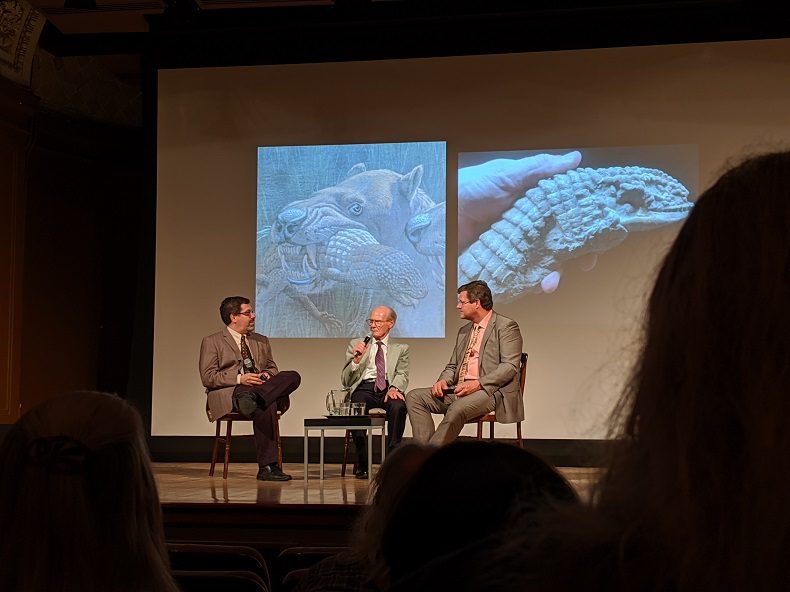
When the National Museum of Natural History, here in D.C., was planning to demolish their fossil hall and build a new one, they knew they would have to deal with something big: Six huge murals. They’re classics, painted between 1960 and 1974, showing wild assemblages of animals from different points in our planet’s history. The museum used digital photography to capture them in such detail that they could reprint them at full size, took them off the walls, rolled them up, and put them in storage.
The museum also got in touch with the artist, Jay Maternes, a very influential paleoartist. He’s in his 80s now and he still lives in the D.C. area, so earlier this week they invited him to the museum’s auditorium to talk about his art, animals, and the process of painting the murals.
Matternes was always interested in art and science. “I would implore my parents to take me to the Denver Natural History Museum,” he said. “They frequently indulged me in that request.” Later they lived in Philadelphia and every Saturday he went to either the zoo or the Academy of Natural Sciences. On those visits, he would produce reams of drawings of the animals, alive and dead.
Apparently all this enthusiasm could have just as well gone in another direction, though. “I had a great passion for airplanes as well.” Eventually he found his way to art school at the Carnegie Institute of Technology (now Carnegie Mellon University). He apprenticed at the Carnegie Museum of Natural History and started a career in paleoart.
The murals at NMNH were painted in place. The museum provided scaffolding, and Matternes only fell off once, but it sounded memorable. (He landed flat on his back and managed to throw the iron bar he was holding onto away from him, so he wasn’t injured.) An audience member asked Matternes if he’d ever had an assistant, and he revealed his perfectionist streak; he said he never wanted one, because he just assumed he wouldn’t be happy with their work and would want to redo it. Curators sometimes grumbled about how long it was taking.
His work started with the bones. Since he was usually drawing extinct animals, which rarely have complete skeletons, he would have to fill in gaps with bones from relatives, including animals that live now. Once he had all of the elements of the skeleton straight, he would draw the skeleton. Then, on another sheet, he would draw the muscles that go over the skeleton, using his knowledge from staring at—and dissecting—modern mammals to attach all of the skeletal muscles in the right place. Finally, he would look at the muscles and cover them with the animal’s outer layer. An animal that is related to gazelles and probably lived a gazelle’s lifestyle got gazelle-like coloring. Another seemed like it might have been similar to a giraffe.
Next he arranged all of the animals in a sketch, and then a small painting. He tried to make their feet visible, even if it that wasn’t realistic; “The feet are extremely revealing about the life mode of that particular animal,” he told us. He called the mural “an abstraction,” which seemed odd for such careful, science-based drawings of actual species. He explained: The mural brought together many animals that wouldn’t necessarily have been all in one place. The predators and prey would not have been that close together.
Finally, he transferred the painting to the wall, working behind a barrier so that visitors couldn’t see him. He could hear them, though. He recalled listening to a man helpfully explaining to a woman that a slab of rock was covered in dinosaur footprints—all very interesting, and reasonably accurate, except that they were the footprints of extinct mammals. And the correct information was right there on the label! From the reaction of the museum professionals in the room (including the friend sitting next to me) this is just how visitors are.
Matternes picked up a lot of knowledge in his decades of carefully considering animals. He can talk in great detail about what the characteristics of different mammal feet. He said he once had “a bit of a contretemps” with Remington Kellogg, who retired in 1962 as the director of NMNH, then the United States National Museum. A particular extinct mammal – I missed the name – had been mounted with its legs splayed, but Matternes painted it with its legs underneath it. Kellogg asked him why, annoyed that the painting didn’t match the fossil. “With respect, Dr. Kellogg, I do not think the skeleton is properly mounted,” he told him.
Fifty years later, he pointed out, the animal is in the new fossil hall–and it’s still in that splay-legged pose.
Photo: Me. I didn’t have time to contact the press office and beg for images of his work, but if you want to see more you can buy a new book about his art, coming out next week.